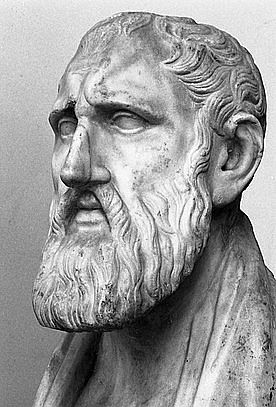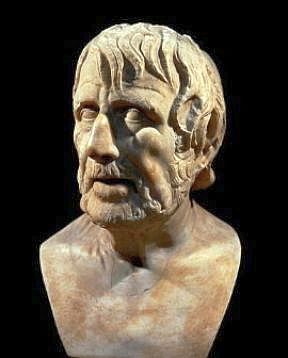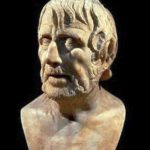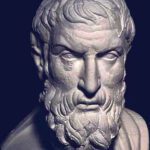In de vorige berichten heb ik gekeken naar mijn favoriete stoïcijnse filosofen, Epictetus en Marcus Aurelius, het is nu tijd om in de geschiedenis van de stoïcijnse filosofie te duiken!
Voor degenen onder ons die leven in de echte wereld, is er één tak van de filosofie die speciaal voor hen is gecreëerd: het stoïcisme. Het is een filosofie die is ontworpen om ons veerkrachtiger, gelukkiger, deugdzamer en wijzer te maken – en als gevolg daarvan betere mensen, betere ouders en betere professionals te zijn.
Voor de gemiddelde persoon is deze levendige, actiegerichte en paradigma-veranderende manier van leven een synoniem geworden voor ‘emotieloosheid’. Gegeven dat feit alleen al, klinkt ‘stoïcijnse filosofie’ op het eerste gezicht als het laatste waar iemand iets over zou willen horen, laat staan dat hij er dringend behoefte aan zou hebben in het dagelijks leven.
Het is moeilijk om een woord te vinden dat een groter onrecht is aangedaan dan ‘Stoïcijns’.
In zijn rechtmatige betekenis is het stoïcisme een hulpmiddel bij het nastreven van zelfbeheersing, doorzettingsvermogen en wijsheid: iets dat je gebruikt om een geweldig leven te leiden, in plaats van een esoterisch veld van academisch onderzoek. Zeker, veel grote geesten uit de geschiedenis begrepen het stoïcisme niet alleen voor wat het werkelijk is, ze zochten het ook op: George Washington, Walt Whitman, Frederik de Grote, Eugène Delacroix, Adam Smith, Immanuel Kant, Thomas Jefferson, Matthew Arnold, Ambrose Bierce, Theodore Roosevelt, William Alexander Percy, Ralph Waldo Emerson. Ze lazen, bestudeerden, citeerden of bewonderden allemaal de stoïcijnen.
Stoïcisme
Het stoïcisme is een school in de hellenistische filosofie, opgericht door Zeno van Citium in Athene.
Het is een filosofie van persoonlijke ethiek, geïnspireerd door haar logicasysteem en haar visie op de natuurlijke wereld. Volgens de leringen ervan wordt de weg naar eudaimonia (geluk of gelukzaligheid) gevonden in het accepteren van het moment zoals het zich aandient, en zich niet te laten beheersen door het verlangen naar plezier of door de angst voor pijn.

Oorsprong
De naam “Stoïcisme” is afgeleid van de Stoa Poikile of “geschilderde veranda“, een colonnade versierd met mythische en historische gevechtsscènes, aan de noordkant van de Agora in Athene. De geschilderde veranda, gebouwd in de 5e eeuw voor Christus – de ruïnes ervan zijn nog steeds zichtbaar – is de plek waar Zeno en zijn discipelen bijeenkwamen voor discussie. Hoewel zijn volgelingen oorspronkelijk Zenoniërs werden genoemd, is het de ultieme eer voor Zeno’s nederigheid dat de filosofische school die hij stichtte, in tegenstelling tot bijna elke school en religie ervoor of daarna, uiteindelijk niet zijn naam droeg.
Zeno’s kennismaking met de filosofie
Volgens een oude bron was Zeno op zakenreis voor zijn vader, een koopman, toen de boot waarop hij zat schipbreuk leed. Volgens het verhaal was Zeno aangespoeld aan de kust bij Athene en toen hij de stad binnenkwam, stopte hij om rond te snuffelen bij een boekenstalletje. Daar begon hij Xenophons Memorabilia van Socrates te lezen en was zo onder de indruk van de figuur van Socrates dat hij de boekhandelaar vroeg of er nog mannen zoals hij in Athene te vinden waren. Op dat moment liep de cynische filosoof Crates voorbij en de boekhandelaar zei ‘volg die man’.
Zo maakte Zeno kennis met de filosofie.
Zeno besloot zelf geen cynicus te worden en keek naar andere filosofen in Athene. Hij studeerde vervolgens bij Stilpo van Megara, misschien wel tien jaar. Stilpo was, net als Zeno, geneigd tot een cynische ethiek, maar als lid van de Megarische school, had die ook een sterke interesse in logica, iets dat later een belangrijk onderdeel van de stoïcijnse filosofie zou worden.
De oude biografie van Stilpo vermeldt talloze ruzies met Zeno’s vorige leraar Crates. Eén passage beschrijft dat Crates met geweld probeert Zeno van Stilpo te verwijderen in een poging hem terug te geven aan de Cynici. Er wordt ons ook verteld dat Zeno tijd doorbracht in de Academie, luisterend naar de lezingen van zowel Xenocrates als Polemo. Er is gesuggereerd dat Zeno’s eigen pantheïstische opvatting van de natuur werd beïnvloed door Polemo en in het bijzonder door zijn interpretatie van Plato’s
Timeus. Het was uit deze mix van invloeden – cynische ethiek, Megariaanse logica en platonische natuurkunde – dat Zeno langzaam zijn eigen kenmerkende filosofische standpunt smeedde.
Leer
De Stoïcijnen staan vooral bekend om hun leer dat ‘deugd het enige goede is’ voor mensen, en dat externe zaken – zoals gezondheid, rijkdom en plezier – op zichzelf niet goed of slecht zijn (adiaphora), maar waarde hebben als ‘materiële zaken’ waarmee de deugd kan handelen.
Naast de aristotelische ethiek vormt de stoïcijnse traditie een van de belangrijkste fundamentele benaderingen van de deugdethiek. De stoïcijnen waren ook van mening dat bepaalde destructieve emoties het gevolg waren van beoordelingsfouten, en zij waren van mening dat mensen moesten streven naar het handhaven van een wil (prohairesis genoemd) die ‘in overeenstemming is met de natuur‘.
Daarom dachten de stoïcijnen dat de beste indicatie van de filosofie van een individu niet was wat iemand zei, maar hoe iemand zich gedroeg. Om een goed leven te kunnen leiden, moest je de regels van de natuurlijke orde begrijpen, omdat ze dachten dat alles in de natuur geworteld was.
Het stoïcisme onderwijst de ontwikkeling van zelfbeheersing en standvastigheid als middel om destructieve emoties te overwinnen; de filosofie stelt dat door een heldere en onbevooroordeelde denker te worden, iemand de universele reden (logos) kan begrijpen.
Het belangrijkste aspect van het stoïcisme betreft het verbeteren van het ethische en morele welzijn van het individu: “Deugd bestaat uit een wil die in overeenstemming is met de natuur“. Dit principe is ook van toepassing op het gebied van interpersoonlijke relaties; “vrij te zijn van woede, afgunst en jaloezie” en zelfs slaven te accepteren als “gelijken, omdat alle mensen gelijkelijk producten van de natuur zijn“.
Veel stoïcijnen – zoals Seneca en Epictetus – benadrukten dat, omdat ‘deugd voldoende is voor geluk‘, een wijze (iemand is die wijsheid heeft verworven en een ‘goed mens‘ is) emotioneel veerkrachtig zou zijn in geval van tegenslag. Dit geloof is vergelijkbaar met de betekenis van de uitdrukking “stoïcijnse kalmte“.

Seneca’s stoïcijnse troost
Seneca werd in 41 na Christus beschuldigd van overspel met Julia Livilla, de zus van keizer Caligula. Hij werd kort daarna verbannen naar Corsica, waar hij drie brieven met “troost” schreef.
De Consolatione ad Marciam is een werk van Seneca, geschreven rond 40 na Christus. Seneca was hoogstwaarschijnlijk gemotiveerd om deze troostbrief aan Marcia te schrijven om haar gunst te winnen. Marcia was de dochter van een vooraanstaand historicus, Aulus Cremutius Cordus, en de enorme rijkdom en invloed van haar familie inspireerde Seneca hoogstwaarschijnlijk tot het schrijven van deze troostbrief. In het essay houdt hij vast aan filosofische abstracties met stoïcijnse voorschriften over leven en dood. Voor een brief die troost moet bieden, mist hij met name empathie voor Marcia’s individuele verdriet en verlies.
Marcia rouwde meer dan drie jaar actief om de dood van haar zoon Metilius. In De Consolatione ad Marciam probeert Seneca haar ervan te overtuigen dat het lot van haar zoon, hoe tragisch ook, geen verrassing had mogen zijn. Ze kende toch veel andere moeders die hun zoons hadden verloren; waarom zou ze verwachten dat haar eigen zoon haar zou overleven?
De erkenning, en zelfs de verwachting, van de slechtst mogelijke uitkomst is een grondbeginsel van Seneca’s stoïcijnse filosofie. Terwijl Seneca sympathiseerde met Marcia, herinnerde hij haar eraan dat ‘we geboren zijn in een wereld van dingen die allemaal voorbestemd zijn om te sterven’, en dat als ze kon accepteren dat niemand garanties heeft voor een rechtvaardig leven (dat wil zeggen, een leven waarin zonen altijd hun moeders overleven), dan kon ze eindelijk een einde maken aan haar rouw en de rest van haar leven in vrede leven.
In de De Consolatione ad Helviam Matrim (gedateerd ongeveer 42/43 n.Chr.) troost Seneca zijn moeder: hij voelt geen verdriet, daarom moet ze niet rouwen om zijn afwezigheid. Hij noemt zijn ballingschap louter een ‘verandering van plaats’ en verzekert haar dat zijn ballingschap hem geen gevoelens van schande heeft bezorgd. Seneca noemt het sterke karakter van zijn moeder een deugd die haar in staat zal stellen zijn afwezigheid te verdragen.
Seneca’s ogenschijnlijk positieve kijk op zijn eigen ballingschap volgt zijn stoïcijnse filosofische leerstelling dat men niet van streek moet raken door oncontroleerbare gebeurtenissen. Dit citaat uit De Consolatione ad Helviam toont Seneca’s beschrijving van zijn leven als draaglijk en zelfs geestelijk plezierig.
“Ik ben vrolijk en opgewekt, alsof ik onder de beste omstandigheden ben. En inderdaad, nu zijn zij de beste, aangezien mijn geest, verstoken van alle andere zorgen, ruimte heeft voor zijn eigen activiteiten, en zich ofwel verheugt in gemakkelijkere studies, ofwel opstaat, verlangend naar de waarheid, naar de overweging van zowel de eigen aard als die van het universum…“
Seneca schreef De Consolatione ad Polybium rond 43/44 na Christus. Deze Consolatio richt zich tot Polybius, de literaire secretaris van keizer Claudius, om hem te troosten over de dood van zijn broer. Het essay bevat de stoïcijnse filosofie van Seneca, met bijzondere aandacht voor de onontkoombare realiteit van de dood.
Hoewel het essay over een zeer persoonlijke kwestie gaat, lijkt het essay zelf niet bijzonder empathisch voor het unieke geval van Polybius, maar eerder een breder essay over verdriet en rouw. In feite komt de lezer nooit de naam van de overleden broer van Polybius te weten.
Seneca moedigt Polybius aan om zichzelf af te leiden van verdriet vanwege zijn drukke werkschema. Er vindt in de brief een toonwisseling van het troosten van Polybius naar het vleien van keizer Claudius plaats. Sommigen zeggen dat deze toonwisseling duidt op de betrokkenheid van een andere auteur.
Het wordt echter algemeen aanvaard dat deze toonverandering niets meer was dan de wanhopige poging van Seneca om aan ballingschap te ontsnappen en terug te keren uit Corsica.
Opkomst, ondergang en wederopstanding
Het stoïcisme bloeide in de hele Romeinse en Griekse wereld tot de 3e eeuw na Christus, en onder zijn aanhangers bevond zich keizer Marcus Aurelius. Het kende een achteruitgang nadat het christendom in de 4e eeuw na Christus de staatsreligie werd. Sindsdien heeft het een opleving gekend, met name in de Renaissance (neostoïcisme) en in de hedendaagse tijd (modern stoïcisme).


